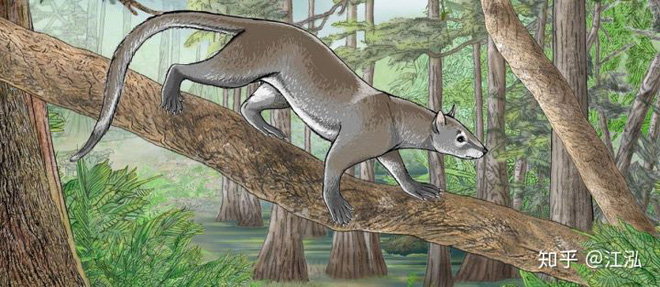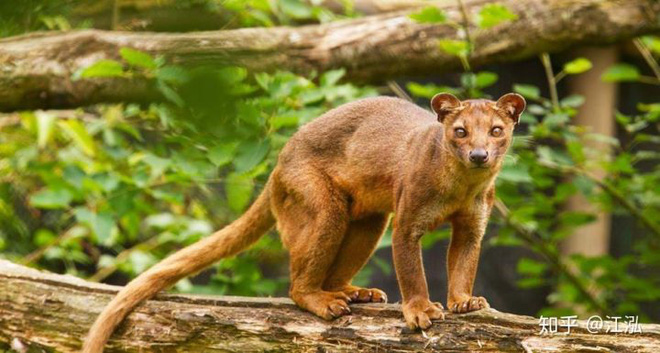New archaeological discoveries show that cats and dogs previously shared a common ancestor
Dogs and cats are now seen as friends who live with humans, according to their appearance and personality, some will like to keep dogs and some will choose cats to be friends with. But despite their differences in personality and appearance, archaeologists have recently discovered that 55 million years ago, they shared a common ancestor.

Dormaal is a small village located in the middle of Belgium and it seems that this area is very strange to most people. But if you are a "believer" of Belgian beer, then surely there will be people know here because this village is the home of the famous Hof Ten Dormaal Blond beer.
In addition to brewing, Dormaal is also known as an area with a lot of paleontological fossils extremely famous for many of the species of The Eocene found here.
Based on the two jaw bone fossils discovered here in the 1960s, paleontologists believe they belong to a small prehistoric cat - Miacis Latour, commonly found in North America.

Recovering image of prehistoric cat - Miacis Latour.
A team led by paleontologist Floreal Sole from the Royal Academy of Natural Sciences in Brussels conducted an excavation in this village and discovered many other fossil samples. together.
By analyzing early fossils, the team identified them from at least 40 prehistoric mammals, of which 280 fossils belong to the same unidentified species. From excavated molars, paleontologists believe that they most likely belonged to a small-sized ancient cat.


Newly discovered fossils of this species include teeth, jaws and ankles. From the bone shape of the teeth, paleontologists identified them as a completely new species and had extremely unique properties.
In 2014, Sole and his research team launched a study called "Dental and tarsal anatomy of 'Miacis' latouri and a phylogenetic analysis of the repeated carnivoraforms (Mammalia, Carnivoramorpha)", in this research paper, they named the new animal Dormaalocyon. In which Dormaal is the name of the area where the fossil was found and ocyon in ancient Greek "Kyon" means dog.


By analyzing the fossil records, paleontologists identified Dormaalocyon as a small predator with a total body length of only about 1 meter and weighs 1kg.
Judging from the simulated images, it can be seen that Dormaalocyon is an animal whose appearance is a mixture of dogs, weasels and squirrels, in fact they can be almost identical to the Fossa (Cryptoprocta Ferox). Lives in Madagascar today.

Fossa is a carnivore, shaped like a cat. It is endemic to Madagascar, belonging to the Eupleridae family, Carnivorous, closely related to the mongoose.

The biology classification of this species has been controversial due to its similar physical characteristics to cats, but another feature indicates a close relationship with the civet.
Dormaalocyon has a small, pointed muzzle with large eyes and triangular ears. They have a long neck, quite flexible body and a long tail to help them balance the body while in the tree.
They possess 4 strong and muscular limbs with five toes per table and curved claws. Judging from the overall structure of this animal, paleontologists identify it as a very good tree-climbing animal.
In addition, they also identified this as a sex deformity (Sexual dimorphism), males are larger in size and much stronger than females.
The discovery of Dormaalocyon is of great significance. Biological analysis shows that this is the oldest carnivore (Carnivoramorpha) ever discovered by humans. The carnivorous form is a large branch of the mammalian class, and includes the extinct Carnivora and Miacoidea (an anomalous family that has been divided into two carnivorous families: Miacidae and Viverravidae. Paleocene and Eocene, about 66-33 million years ago).
Most of the carnivorous mammals on Earth today belong to the Carnivora family, including families such as dogs, cats, bears, weasels, etc.So it can be said that cats and dogs once shared a common ancestor. Dormaalocyon.

Dormaalocyon's position on the evolutionary tree of carnivores.

Dormaalocyon lived in Europe at the beginning of the Eocene 55 million years ago. At that time, the Earth's temperature was higher than it is today and Europe has dense and wet rainforest. Dormaalocyons often climb trees through rainforests to hunt smaller mammals and insects.
Although the Dormaalocyon is modest in size, it is of great significance to the evolution of today's mammals on Earth. Due to the limited fossil materials, we have always been "dreamy" about the evolution of mammals during the Paleocene. The discovery of Dormaalocyon proves that during the extremely warm period of the Paleocene / Eocene, carnivores emerged with diversity from Europe to North America, evolving into ancient small cats and predator is almost fox.
Studies on primates also indicate that at Paleocene, Europe is likely to be the evolutionary center of early mammals.

The discovery of Dormaalocyon means a lot to us in exploring the origins of predatory mammals today. Whether it's cats, dogs, lions, bears, etc., they shared a common ancestor 55 million years ago!

You should read it
- Natural disasters can kill insects and invertebrates
- Prehistoric boats were excavated in India
- Why aren't there giant mammals in the dinosaur era?
- Wifi to school!
- Why do whale fin fins have five fingers that look like human hands?
- Excavating an iron factory dating back to thousands of years in Cambodia
- Alibaba set up AI research facility with Singapore university
- Good group names and meanings
May be interested
- Decipher the strange behavior often seen in dogs
 let's learn some of the behaviors that puppies often do to understand more about these close friends of humans.
let's learn some of the behaviors that puppies often do to understand more about these close friends of humans. - Why are cats afraid of water?
 here's what a veterinarian has to say about water aversion, from evolutionary traits to cats' unique sensitivities.
here's what a veterinarian has to say about water aversion, from evolutionary traits to cats' unique sensitivities. - Arabian cat cats were discovered after ten years of searching
 a new breed of cat called arabian cat has just been discovered after 10 years of searching is receiving much attention from the scientific community.
a new breed of cat called arabian cat has just been discovered after 10 years of searching is receiving much attention from the scientific community. - What is an orange cat? Why are some cats orange?
 orange cats are everywhere, from the iconic character garfield to the tabby cat lounging in the sun. but what makes an orange cat's color so distinctive?
orange cats are everywhere, from the iconic character garfield to the tabby cat lounging in the sun. but what makes an orange cat's color so distinctive? - Looking for answers to the question: Cats really like to eat fish?
 most people assume that cats like to eat fish. but according to experts, fish is not the favorite, favorite food of cats, even fish is not good food for cats.
most people assume that cats like to eat fish. but according to experts, fish is not the favorite, favorite food of cats, even fish is not good food for cats. - Mimicking human behavior, the hero dog saves earthworms from the hot road surface
 a woman in illinois shared a video about her dog because it had an unusual behavior of saving earthworms from the hot road.
a woman in illinois shared a video about her dog because it had an unusual behavior of saving earthworms from the hot road. - Scientists reveal a simple way to communicate with cats
 cats have a reputation for being cold (and clumsy), but if you and your cat aren't bonding, a language barrier is probably the main culprit.
cats have a reputation for being cold (and clumsy), but if you and your cat aren't bonding, a language barrier is probably the main culprit. - Thanks to AI, it predicts what dogs will look like after 10,000 years
 geneticists in collaboration with veterinarian ernie ward at basepaws, a genetic testing company for pets in california, usa, have made predictions about dogs in the future thanks to artificial intelligence.
geneticists in collaboration with veterinarian ernie ward at basepaws, a genetic testing company for pets in california, usa, have made predictions about dogs in the future thanks to artificial intelligence. - Solitary jaguar dared to plunge into the bait of wild dogs
 while the wild dogs were tearing up the antelope, a male jaguar suddenly appeared, rushing to take away the other half of the prey and climb onto the roadside tree.
while the wild dogs were tearing up the antelope, a male jaguar suddenly appeared, rushing to take away the other half of the prey and climb onto the roadside tree. - How to handle and escape when the dog attacks
 what to do when a dog attacks? this is a difficult answer because when a dog attacks, most people are in a state of panic and cannot control themselves, leading to a bad situation.
what to do when a dog attacks? this is a difficult answer because when a dog attacks, most people are in a state of panic and cannot control themselves, leading to a bad situation.










 Why is it lower than the sea level but there is no big lake in Turpan basin?
Why is it lower than the sea level but there is no big lake in Turpan basin? Close-up of the world's largest excavator super monster, weighing up to 13,500 tons
Close-up of the world's largest excavator super monster, weighing up to 13,500 tons NASA scientists discovered evidence of a parallel universe, where time runs ... backwards
NASA scientists discovered evidence of a parallel universe, where time runs ... backwards Only from a photo on Twitter, scientists discovered a completely new type of parasite
Only from a photo on Twitter, scientists discovered a completely new type of parasite US declines more information about UFO: The size of a suitcase, with the speed that makes the world's fastest fighter have to smell
US declines more information about UFO: The size of a suitcase, with the speed that makes the world's fastest fighter have to smell New research shows that North America's 'cousin' of Velociraptor originated from Asia
New research shows that North America's 'cousin' of Velociraptor originated from Asia